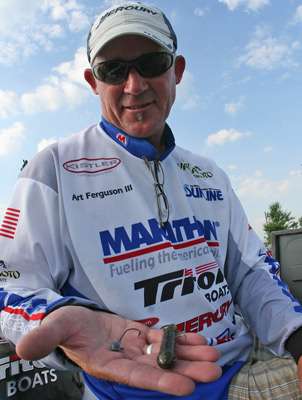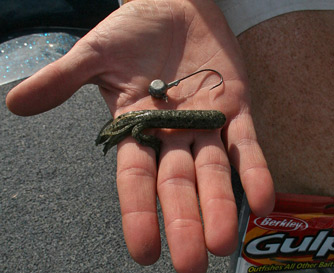
SANDUSKY, Ohio – Drop shotting may be the sexy new technique for catching Lake Erie smallmouth, but Great Lakes aficionados know that under the right conditions, it’s still hard to beat a tube.
At least a third of the final 12 anglers fishing the recent Bass Pro Shops Bassmaster Northern Open on Erie were throwing a tube and it accounted for the biggest fish for John Devries, with a 26-pound, 7-ounce stringer. While many anglers found the tube to be a drum catcher on Erie’s WestBasin, Devries and others have honed a technique called “cracking” to boat trophy smallmouth instead.
“Bass look up while a drum’s mouth is pointing down,” Devries said. “Getting it up off the bottom helps catch more smallmouth – when it comes up, they see it. The bait is probably only coming up a foot or a foot and a half. Gobies don’t get too far off the bottom. What’s more important is that it’s coming towards the boat.”
Devries uses a green/melon-colored tube paired with a 3/8-ounce custom-poured “pill head” jighead with a special light-wire hook that he orders from Japan. The bite is essentially a reaction strike, triggering bass that he picks out on his electronics.
“A lot of times, you can see fish on the graph,” Devries said. “Some guys will fish right under the boat, but that doesn’t always work. If you are seeing them, but they won’t react to your bait, mark a waypoint, back the boat off half a cast and crack a tube.”
Devries wasn’t the only angler throwing a tube, but he may have been the only finalist throwing one in such an extreme way. If Devries was on one end of the tube spectrum, third-place finisher Michael Murphy was on the other.
Murphy went with a light jighead and paired that with a Reins tube in either green pumpkin or camo. Then he drifted along “seams” in 12 to 15 feet of water where the rocks turned to sand.
 “I was using as light of a weight as I could get away with: 1/8 ounce in some cases if I could,” Murphy said. “You are drifting with the waves, so your bait is going to be on the bottom anyway. I think the guys throwing heavier weights were missing bites.”
“I was using as light of a weight as I could get away with: 1/8 ounce in some cases if I could,” Murphy said. “You are drifting with the waves, so your bait is going to be on the bottom anyway. I think the guys throwing heavier weights were missing bites.”
He wasn’t using a tube exclusively though. A drop shot accounted for most of his catch, but there were times like on the final day, when the tube helped pull in some big upgrades. Murphy boated 22 pounds, 2 ounces on Saturday and made a big move, only 2 pounds behind winner Nate Wellman when the scales settled.
“I put the drop shot down when I had a 16-pound limit because when you caught one on the tube, it was going in the well,” Murphy said.
Unlike both Murphy and Devries, Art Ferguson has built his career and guide service around throwing tubes and he did so exclusively on Lake Erie, finishing in 11th place. His own Provider Performance Series tubes and tube jigs in Fiesta Melon did the damage, drifting along the bottom of Lake Erie’s plentiful rock reefs.
Ferguson agreed with Murphy that lighter is better, mostly to keep the bait from snagging in the rocks as he slowly drifts along.
“Lots of guys were throwing heavier stuff, but I was using 1/4-ounce most of the time, working it real slow over structure,” Ferguson said. “The presentation I use is more subtle and the light weight wasn’t getting hung up as much. You are not feeling the cover as much, but the 1/4-ounce jig comes through the gravel better.”
Unlike the more target-specific presentation Devries used, Ferguson focused on roaming smallmouth and drifted wide areas to find them. Again, he stressed the importance of keeping artificial bait action to a minimum.
“I did more dragging, making a long cast,” Ferguson said. “I was trying to cover water. The fish seemed to move up and off the reef, so I figured moving would allow me to intercept fish moving both ways. I guide for a living and 99 percent of the time, I will outfish my clients dragging if they try to hop it.”
The bottom line is, whether dragging or hopping, don’t forget to pack a tube on any trip to the Great Lakes. It may not get as much press as a drop shot, but there are times when it will put more big smallmouth in the boat.




